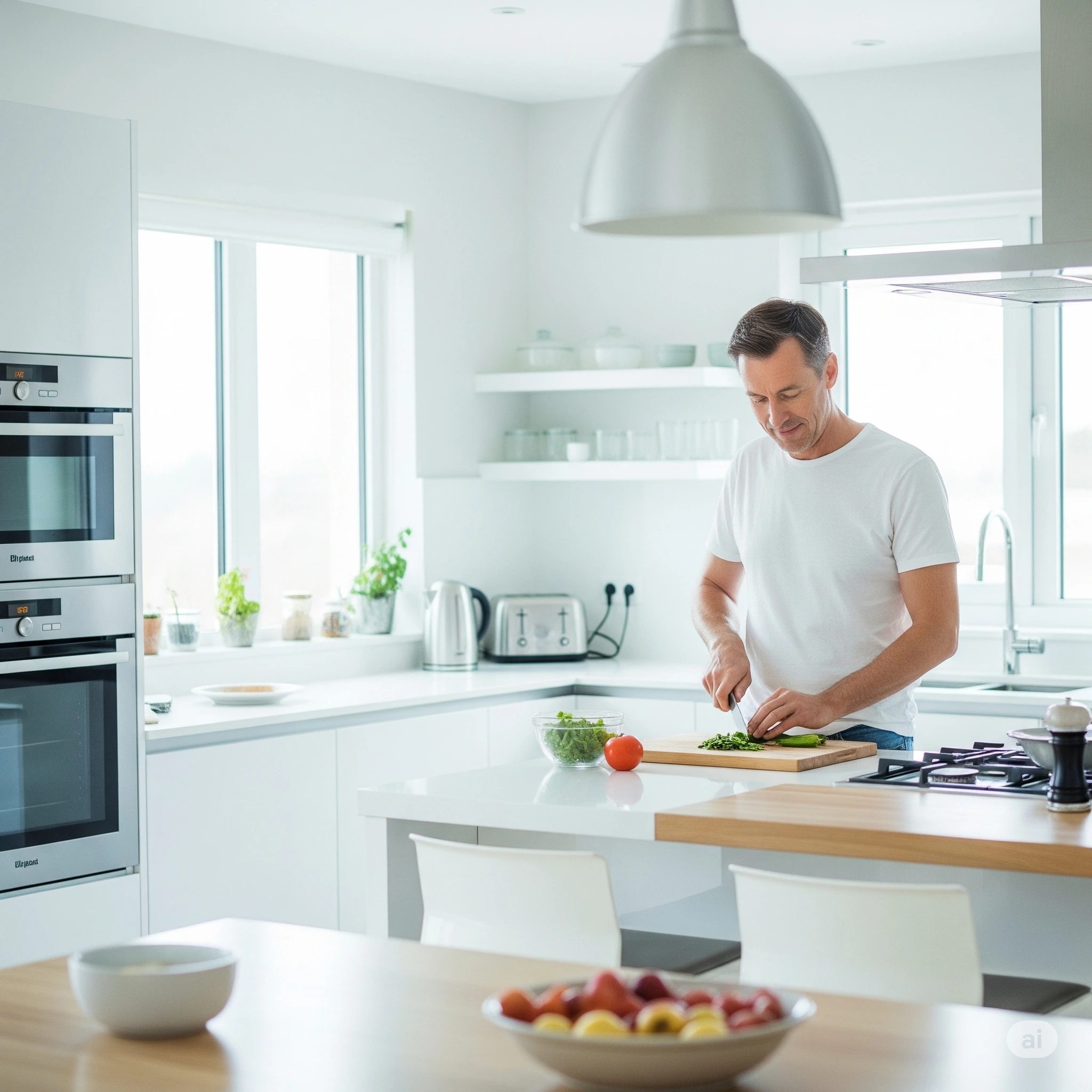The kitchen is truly the heart of many homes – a bustling center for cooking, gathering, and creating memories. However, with its combination of heat, sharp objects, electrical appliances, and busy activity, it can also be one of the most hazardous rooms if proper precautions aren’t taken. Practicing good kitchen safety is paramount to preventing accidents, injuries, and foodborne illnesses, ensuring your culinary space remains a source of joy, not danger. This guide provides essential kitchen safety tips for every household, with special considerations for common practices in regions like Indonesia.
Fire Prevention & Safety: A Top Priority
Kitchen fires are a leading cause of home fires. Stay vigilant with these measures:
- Never Leave Cooking Unattended: This is the golden rule. If you must leave the kitchen, even for a moment, turn off the stovetop or oven.
- Keep Flammables Away: Store oven mitts, wooden utensils, dish towels, paper products, food packaging, and curtains away from your stovetop, oven, and other heat-generating appliances.
- Clean Grease Buildup Regularly: Grease is highly flammable. Regularly clean your stovetop, oven, range hood, and exhaust fan filters to prevent grease accumulation.
- Handle Grease Fires Correctly:
- NEVER use water on a grease fire – it will cause the fire to spread.
- If a small grease fire starts in a pan, try to smother the flames by sliding a lid over the pan and turning off the burner. Leave the lid on until the pan is completely cool.
- For larger grease fires, or if you’re unsure, evacuate everyone and call emergency services immediately.
- Have a Fire Extinguisher (and Know How to Use It): Keep a multi-purpose (Class ABC) or ideally a Class K fire extinguisher specifically designed for kitchen fires readily accessible. Ensure all responsible household members know how to operate it. Check the expiry date and pressure regularly.
- Install and Maintain Smoke Detectors: Install smoke detectors near, but not in, the kitchen to avoid false alarms from normal cooking smoke. Test them monthly and change batteries at least once a year.
- Watch Your Sleeves: Avoid wearing loose-fitting clothing, especially with long, dangling sleeves, when cooking over open flames or hot surfaces.
- Turn Pot Handles Inward: Keep pot and pan handles turned towards the back or center of the stovetop to prevent them from being accidentally knocked over, especially important if there are children around.
Burn Prevention: Handle with Care
Burns are common kitchen injuries. Protect yourself:
- Use Oven Mitts or Pot Holders: Always use dry oven mitts or thick pot holders when handling hot pots, pans, baking sheets, or dishes from the oven or microwave.
- Open Lids Carefully: Tilt pot and pan lids away from your face and body when opening them to allow steam to escape safely, preventing steam burns.
- Beware of Hot Liquids & Oil: Hot oil and liquids can splatter and cause severe burns. Use splatter screens if necessary and add food to hot oil gently.
- Establish a “Kid-Free Zone”: Keep young children at least 3 feet (about 1 meter) away from the stove, oven, and other hot appliances while cooking.
- Test Temperatures: Before serving food or liquids, especially to children or the elderly, test the temperature to prevent burns.
Cut Prevention & Knife Safety: Sharp Skills, Safe Handling
Knives are essential tools but require respect:
- Use Sharp Knives: A sharp knife is safer than a dull one because it requires less pressure to cut, reducing the chance of slipping.
- Cut on a Stable Surface: Always use a stable, non-slip cutting board. Place a damp cloth or paper towel under the board if it slides.
- Cut Away From Your Body: Direct the knife blade away from your body and fingers.
- Keep Fingers Curled: When chopping, curl your fingertips under like a claw, guiding the knife with your knuckles.
- Store Knives Safely: Use a knife block, a magnetic strip, or in-drawer knife organizers. Don’t leave them loose in a drawer.
- Never Try to Catch a Falling Knife: Step back and let it fall.
- Wash Knives Separately: Don’t put sharp knives in a sink full of soapy water where they can’t be seen. Wash them carefully one by one.
- Carry Knives Safely: Point down and by your side when carrying.
Preventing Slips, Trips, and Falls
The kitchen floor can easily become hazardous:
- Clean Up Spills Immediately: Water, grease, or food spills make floors slippery.
- Keep Floors Dry and Clutter-Free: Avoid leaving items like bags, boxes, or pet toys on the floor.
- Use Non-Slip Mats: Place non-slip mats or rugs in areas prone to wetness, such as in front of the sink. Ensure rugs have a non-skid backing.
- Ensure Adequate Lighting: Good lighting helps you see potential hazards.
Electrical Safety: Handle with Caution
- Keep Appliances Away From Water: Never operate electrical appliances near the sink or with wet hands.
- Don’t Overload Outlets: Avoid plugging too many appliances into one outlet or extension cord.
- Unplug Small Appliances: Unplug toasters, blenders, and other small appliances when not in use and before cleaning.
- Check Cords Regularly: Inspect cords for frays, cracks, or damage. Replace damaged cords or appliances.
- Never Use Damaged Appliances.
Gas Safety (Especially with LPG Cylinders)
For households using gas stoves, particularly with LPG cylinders common in Indonesia:
- Proper Installation & Regular Checks: Ensure your gas stove and LPG cylinder connections are installed by a qualified technician and checked regularly for leaks or wear.
- Detecting Gas Leaks: If you smell gas (often a rotten egg odor is added to LPG for detection):
- DO NOT operate electrical switches, light matches, or create any sparks.
- Immediately extinguish any open flames.
- Open windows and doors to ventilate the area.
- If safe, turn off the gas supply at the cylinder valve or main shut-off.
- Evacuate the house and call your gas supplier or emergency services from outside.
- Keep Area Clear: Don’t store flammable materials near your gas stove or cylinder.
- Ensure Good Ventilation: Always ensure some ventilation when using a gas stove.
Food Safety & Hygiene: Prevent Foodborne Illness
Proper food handling is crucial for health, especially in warm, humid climates where bacteria can multiply rapidly:
- Wash Hands Thoroughly: Before, during, and after handling food, especially raw meat, poultry, and eggs.
- Prevent Cross-Contamination: Use separate cutting boards, knives, and utensils for raw meats and ready-to-eat foods like fruits and vegetables. Clean all surfaces thoroughly after preparing raw foods.
- Cook Food to Proper Temperatures: Use a food thermometer to ensure meats are cooked to safe internal temperatures.
- Store Food Properly: Refrigerate perishable foods promptly (within two hours, or one hour if the ambient temperature is high, e.g., above 32°C/90°F). Keep raw meats separate from other foods in the refrigerator.
- Clean and Sanitize: Regularly clean and sanitize countertops, cutting boards, sinks, and utensils.
Child Safety in the Kitchen
Make the kitchen a safer place for curious little ones:
- Supervise Closely: Never leave young children unattended in the kitchen, especially when cooking.
- Keep Hazards Out of Reach: Store knives, sharp utensils, cleaning supplies, medications, matches, and lighters in locked cabinets or high shelves.
- Use Safety Latches: Install safety latches on accessible cabinets and drawers containing hazardous items.
- Teach Kitchen Dangers: As children grow, teach them about hot surfaces, sharp objects, and other kitchen hazards.
- Utilize Back Burners: Cook on back burners whenever possible, and keep pot handles turned inward.
General Kitchen Safety Habits
- Be Mindful & Avoid Distractions: Pay attention when cooking or using sharp tools. Avoid distractions like using your phone excessively.
- Know Basic First Aid: Be familiar with basic first aid for minor burns and cuts.
- Keep Emergency Numbers Handy: Post emergency contact numbers in an accessible place.
Conclusion
A safe kitchen is a cornerstone of a safe and healthy home. While the kitchen can present various hazards, cultivating an awareness of potential dangers and consistently practicing these essential safety tips can significantly reduce the risk of fires, burns, cuts, falls, and foodborne illnesses. Make kitchen safety a priority for every member of your household, and enjoy your time creating delicious meals and memories in a secure environment.







Leave a Comment